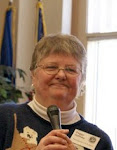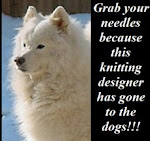Meet a Friend & Fellow Author/Designer
Donna Druchunas
Donna Druchunas
Donna and I recently got together to talk about her new book Ethnic Knitting Exploration - Lithuaina, Iceland and Ireland. I thought I'd share some of that conversation with you. Since I work in Intarsia and Donna works in Fairisle, I thought that you would enjoy the variety.
Peggy - " You call the book Ethnic Knitting Exploration. Why did you choose to use the term Exploration? "

Donna - "This is a three book series. The first book was called Discovery because it was a introduction into the world of ethnic knitting. The second book is Exploration because it provides more techniques for the knitter to go further and explore different sweater constructions and shapes. The last book will be Adventure, because it will go beyond traditional techniques into the adventure of modern ethnic knitting in different countries and it is my hopes that each knitter will depart on their own knitting adventures. "
Peggy - "How do patterns from Lithuania, Iceland and Ireland differ from those in other parts of the world such as South America and Asia? "
Donna - "In Iceland and Ireland, interesting shapes of sweaters have been made. The Icelandic yoke sweater is a seamless design that flows and drapes over the shoulders with no seam-lines to break up the patterning that is knitted on the yoke. It's a flattering design for many figure types, although it may not be appropriate for women with narrow shoulders. My favorite part of knitting yoke sweaters is that when knitted from the bottom up (as they are in Ethnic Knitting Exploration), you start with a large number of stitches after joining the front, back, and sleeves into one piece, and then you decrease several times, so you have fewer and fewer stitches and your knitting goes faster and faster until all that's left to knit is the neckband.
In Ireland, the Aran sweater developed as a variation of the Gansey that was knitted in the round with shoulder straps that separated the front and back of the body and added depth to the neckline. After time, knitters started working these designs back and forth in pieces, with saddles instead of straps. The saddle extends from the top of the sleeve to the neckline. The effect is similar to that of a strap, but the construction is completely different. This design works particularly well on Aran sweaters, because a cable panel that is worked up the center of the sleeve can be extended to the neckband, creating a very striking design feature.
In Lithuania sweaters were not knitted as part of the traditional costume, but they became popular, as they did in Western Europe and America, in the twentieth century. Raglan sweaters are similar, except the decreases are lined up so they create phony "seams" that break up the patterning. This can be used to advantage by those with narrow shoulders. By placing a horizontal band of patterning around the yoke on a raglan sweater, it can create the illusion that one's shoulders are wider. Normally the raglan design is the least flattering on those with narrow shoulders. The raglan shape was popular for Aran sweaters knitted in Ireland in the mid-twentieth century because the shape was easy and fast to make for production knitting. These Aran raglans were knitted flat in pieces and sewn together. The raglan shaping also became popular in Lithuania in the mid-twentieth century, although it is not tied to traditional pattern or texture stitches in that country.
I don't really know much about traditional sweater designs from Asia or South America, actually. In Japan, most knitting books tend to have modern, tailored sweater designs with shaped armholes and set-in sleeves. "
Peggy - "How did you decide which sweater shapes you would choose to teach your approach?"
Donna - "In the series, many shapes will be covered. But I started simple and each book gets a little more complicated. Discovery featured only drop shoulder and modified drop shoulder designs, so newer knitters could focus on the circular knitting and the basic construction of the garments. Exploration includes yoke, raglan, and saddle shoulder designs that result in sweaters that drape more naturally around the shoulders and that can be made with a more customized fit than a drop shoulder design. The third book will talk about more fitted garments. "
Peggy - "The book seems to go way beyond simple instructions to complete a sweater and more into empowering the knitter to use this information to create their own styles. Do you like to encourage designing in knitters? "
Donna - "I think it's empowering to be able to create your own designs. Not that we always have to do that! I enjoy knitting from other people's patterns as much as anyone. But even if you never plan to design your own garments, knowing about how garments should fit, how different types of stitches behave, how garment construction works gives you the ability to alter patterns to suit your own needs and to fit you perfectly. "
Peggy - " You recommend smooth yarn to show off the pattern designs, but do you have any favorites with which you like to work? "
Donna - "It's so hard to pick a favorite yarn! For fine-weight projects, I am currently in love with Koigu Painter's Palette Premium Merino. For medium-weight, there are so many yarns that I love. Here are a few classics that I've used over and over again:
Plymouth Suri Merino for it's soft hand and wonderful drape. Alpaca is not as springy as wool and texture patterns don't "pop" as much as with a more tightly spun yarn, but the results are still fabulous. And colorwork is just gorgeous.
Mission Falls 18/24 Wool is a great superwash alternative for colorwork. Superwash wool opens up a LOT when knitted in cable designs, so wash your swatch to see how the fabric reacts.
Brown Sheep Lamb's Pride Worsted because it's an inexpensive, basic yarn. It's a single, so the stitches look differently than they do when knitted with a plied yarn. I love this yarn for textured knitting. It's not as soft as merino or alpaca, however.
I hate to lists favorites though, because there are so many wonderful yarns on the market these days. I just love to swatch and try them all out! Trying new yarns is one of my favorite parts of the Exploration. "






No comments:
Post a Comment